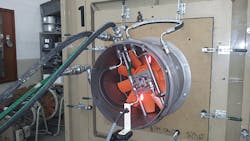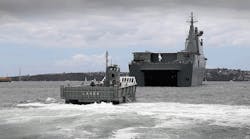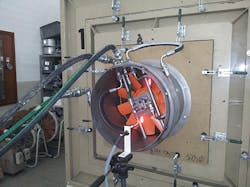Hydraulics Serves Aussie Navy
This file type includes high-resolution graphics and schematics when applicable.
For nearly 40 years, Fluidmecanica SAU, Pontevedra, Spain, has designed and manufactured marine machinery, hydraulic controls and transmission, and pneumatic systems. Last year, four military landing craft worked on by Fluidmecanica were delivered to the Royal Navy of Australia at its HMS Waterhen Naval Base near Sydney. The landing craft operate in conjunction with two Canberra-class landing helicopter dock ships and are qualified under NATO requirements.
Each landing craft is 23.30 meters long and can achieve speeds exceeding 20 knots. Fluidmecanica designed and built the ventilation system for the engine room of each craft. A ventilation system may seem like overkill for a hydraulic system, but the rigors of the application requires the high power density and durability of hydraulics.
Hydraulics on the Move
Two pairs of hydraulically powered blowers rotate at 2,900 rpm to move up to 17,000 m3 of air per hour (10,000 cfm). Each hydraulic gear motor (two connected in series) driving a fan is fed by a variable-displacement hydraulic piston pump powered from each of the landing craft’s two 809-kW (1,080 hp) engines. Hydraulic pressure for each circuit is 280 bar, and maximum flow is 10 lpm. This is where the versatility of hydraulics is important, because fan speed must be controlled independent of engine speed.
Fluidmecanica’s Francisco Oliver Rivera explains that a variable-speed electric drive would not have been practical for this application. “An electric drive is more bulky and weighs about 60% more. It would also be prone to failure under high shock and vibration. NATO shock requirements are especially demanding in boats like this, which may have to operate near shelling fire during operations.”
The pump that drives the fan has variable displacement, so its output per revolution increases or decreases inversely with engine speed, says Rivera. “Each pump has a load-sensing control, so we achieve fixed flow with a metering block. In this case, the flow remains fixed over the engine’s complete range of speed—from 1,000 to 2,800 rpm.
Rivera also says that because the landing craft are designed for use in combat, simplicity and rugged operation were high priorities. “Each hydraulic pump is directly coupled to the engine, so the system automatically starts with the engine. There is no need to switch the fan on or off, because if the engines are not running, the fans are not needed.”
Looking for parts? Go to SourceESB.




